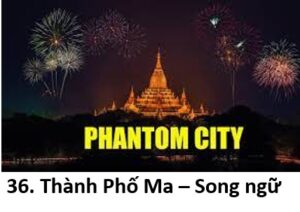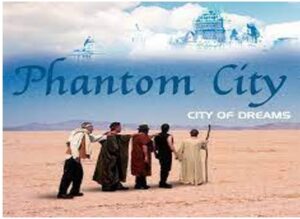Thành Phố Ma – The Phantom City – Song ngữ
English: Zennist Ekacitta.
Việt ngữ: HT. Thích Trí Tịnh.
Compile: Lotus group.

4. Thành Phố Ma – The Phantom City
Chapter 7: The Parable of the Phantom City – Chương 7: Phẩm “Hóa Thành Dụ”.

A group of people are being led by a knowledgeable guide through a wilderness to a place where, they are told, they will find great treasure.
Một nhóm người đang được dẫn dắt bởi một hướng dẫn kiến thức thông qua đồng vắng đến một nơi mà họ đang nói, họ sẽ tìm thấy kho báu vĩ đại.
After some time, the group become weary and disheartened and wish to turn back. The guide tells them that, just a short distance ahead, there is a city where they can lodge and refresh themselves.
Sau một thời gian, nhóm trở nên mệt mỏi và chán nản và muốn quay trở lại. Các hướng dẫn nói với họ rằng, chỉ cần một khoảng cách ngắn phía trước, có một thành phố, nơi họ có thể tạm trú và ăn uống nghĩ ngơi.
They enter the city, and, when they feel better, the city vanishes. The guide explains that he had created it by magic to satisfy their needs, and, now that it has fulfilled its purpose, he has made it disappear.
Họ tiến vào thành phố, và, khi họ cảm thấy tốt hơn, thành phố biến mất. Các hướng dẫn giải thích rằng ông đã tạo ra nó bằng phép thuật để đáp ứng nhu cầu của họ, và bây giờ nó đã hoàn thành mục đích của mình, ông đã làm cho nó biến mất.
The treasure, he says, is near, and if they make one more effort, they will find it. We are then told that the guide is the Buddha; the group of people are disciples; the phantom city is Buddhism; and the treasure is the Buddha Nature.
Các kho tàng, ông nói, là gần, và nếu họ làm cho một nỗ lực nhiều hơn, họ sẽ tìm thấy nó. Sau đó chúng ta biết rằng các hướng dẫn là Phật; các nhóm người là môn đệ; thành phố ma là Phật giáo; và kho báu là Phật Tánh.
Base on Chapter 7 – the short sentence as follow:
Dựa vào Chương 7 – Câu kinh như sau:
“Let us suppose there is a stretch of bad road five hundred yojanas long, steep and difficult, wild and deserted, with no inhabitants around, a truly fearful place. And suppose there are a number of people who want to pass over this road so they can reach a place where there are rare treasures. They have a leader, of comprehensive wisdom and keen understanding, who is thoroughly acquainted with this steep road, knows the layout of its passes and defiles, and is prepared to guide the group of people and go with them over this difficult terrain. “The group he is leading, after going part way on the road, become disheartened and say to the leader, “We are utterly exhausted and fearful as well. We cannot go any farther. Since there is still such a long distance ahead, we would like now to turn around and go back.’
Thí dụ đường hiểm nhiều nạn dữ, dài năm trăm do tuần. Chốn ghê sợ hoang vắng không người. Nếu chúng đông muốn đi qua con đường nầy đến chỗ trân bửu, có một vị Đạo-Sư thông minh sáng suốt khéo biết rõ tướng thông bít của con đường hiểm, dắt chúng nhân muốn vượt qua nạn đó. Chúng nhân được dắt đi giữa đường lười mỏi bạch đạo sư rằng: “Chúng con mệt nhọc lại thêm sợ sệt chẳng có thể đi nữa, đường trước còn xa nay muốn lui về”.
“The leader, a man of many expedients, thinks to himself, What a pity that they should abandon the many rare treasures they are seeking and want to turn and go back! Having had this thought, he resorts to the power of expedient means and, when they have gone three hundred yojanas along the steep road, conjures up a city. He says to the group, ‘Don’t be afraid! You must not turn back, for now here is a great city where you can stop, rest, and do just as you please. If you enter this city you will be completely at ease and tranquil. Then later, if you feel you can go on to the place where the treasure is, you can leave the city.’
Vị Đạo-Sư nhiều sức phương tiện mà tự nghĩ rằng: Bọn này đáng thương, làm sao cam bỏ trân bảo lớn mà muốn lui về. Nghĩ thế rồi dùng sức phương tiện ở giữa đường hiểm quá ba trăm do tuần, hóa làm một cái thành mà bảo chúng nhân rằng: ” Các người chớ sợ, đừng lui về, nay thành lớn nầy có thể dừng ở trong đó tùy ý muốn làm gì thì làm, nếu vào thành nầy sẽ rất được an ổn, nếu có thể lại thẳng đến chỗ châu báu đi cũng được”.
“At that time the members of the group, being utterly exhausted, are overjoyed in mind, exclaiming over such an unprecedented event, ‘Now we can escape from this dreadful road and find ease and tranquility!’ The people in the group thereupon press forward and enter the city where, feeling that they have been saved from their difficulties, they have a sense of complete ease and tranquility.
Bấy giờ, chúng mỏi mệt rất vui mừng khen chưa từng có, chúng ta hôm nay khỏi được đường dữ rất được an ổn. Đó rồi chúng nhân thẳng vào hóa thành sanh lòng tưởng cho rằng đã được độ rất an ổn.
“At that time the leader, knowing that the people have become rested and are no longer fearful or weary, wipes out the phantom city and says to the group, ‘You must go now. The place where the treasure is is close by. That great city of a while ago was a mere phantom that I conjured up so that you could rest.’
Lúc ấy Đạo-Sư biết chúng nhơn đó đã được nghỉ ngơi không còn mỏi mệt, liền diệt hóa thành bảo chúng nhơn rằng: “Các người nên đi tới, chỗ châu báu ở gần đây, thành lớn trước đó là của ta biến hóa ra để nghỉ ngơi thôi”.
“Monks, the Thus Come One is in a similar position. He is now acting as a great leader for you. He knows that the bad road of birth and death and earthly desires is steep, difficult, long and far-stretching, but that it must be traveled, it must be passed over. If living beings hear only of the one Buddha vehicle, then they will not want to see the Buddha, will now want to draw near him, but will immediately think to themselves, The Buddha road is long and far reaching and one must labor diligently and undergo difficulties over a long period before he can ever attain success!
“The Buddha knows that the minds of the living beings are timid, weak and lowly, and so, using the power of expedient means, he preaches two nirvanas in order to provide a resting place along the road.
Các Tỳ-kheo! Đức Như-Lai cũng lại như thế, nay vì các ông mà làm vị đại Đạo-Sư, biết các đường dữ sanh tử phiền não hiểm nạn dài xa nên vượt qua. Nếu như chúng sanh chỉ nghe một Phật thừa thời chẳng muốn thấy Phật, chẳng muốn gần gũi, mà nghĩ thế nầy: “Đạo Phật dài xa lâu ngày chịu cần khổ mới có thể được thành”. Phật biết tâm chúng đó khiếp nhược hạ liệt, dùng sức phương tiện mà ở giữa đường vì để ngơi nghỉ nên nói hai món Niết-bàn. (13)
If living beings choose to remain in these two stages, then the Thus Come One will say to them, ‘You have not yet understood that is to be done. This stage where you have chosen to remain is close to the Buddha wisdom. But you should observe and ponder further. This nirvana that you have attained is not the true one. It is simply that the Thus Come One, using the power of expedient means, has taken the one Buddha vehicle and, making distinctions, has preached it as three.’
Nếu chúng sanh trụ nơi hai bực, đức Như-Lai bấy giờ liền bèn vì nói:” Chỗ tu của các ông chưa xong, bâïc của các ông ở gần với huệ của Phật. Phải quan sát suy lường Niết-bàn đã được đó chẳng phải chân thật vậy. Chỉ là sức phương tiện của Như-Lai, ở nơi một Phật thừa phân biệt nói thành ba.
“The Buddha is like that leader who, in order to provide a place to rest, conjured up a great city and then, when he knew that the travelers were already rested, said to them, ‘The place where the treasure is, is nearby. This city is not real. It is merely something I conjured up.'”
Như vị Đạo-Sư kia vì cho mọi người ngơi nghỉ mà hóa thành lớn, đã biết nghĩ xong mà bảo đó rằng: ” Chỗ châu báu ở gần, thành nầy không phải thật, của ta biến hóa làm ra đó thôi”.
Sources:
Tài liệu tham khảo:
- http://www.sacred-texts.com/bud/lotus/lot16.htm
- http://zennist.typepad.com/zenfiles/2011/11/seven-parables-from-the-lotus-sutra.html
- http://thuvienhoasen.org/p16a591/16-pham-nhu-lai-tho-luong
- https://lotus-happiness.com/seven-parables-of-the-lotus-sutra/
- https://slideplayer.com/slide/14408993/
- https://www.metmuseum.org/art/collection/search/45624
- http://phantomcity.net/cityofdreams.html?i=1
